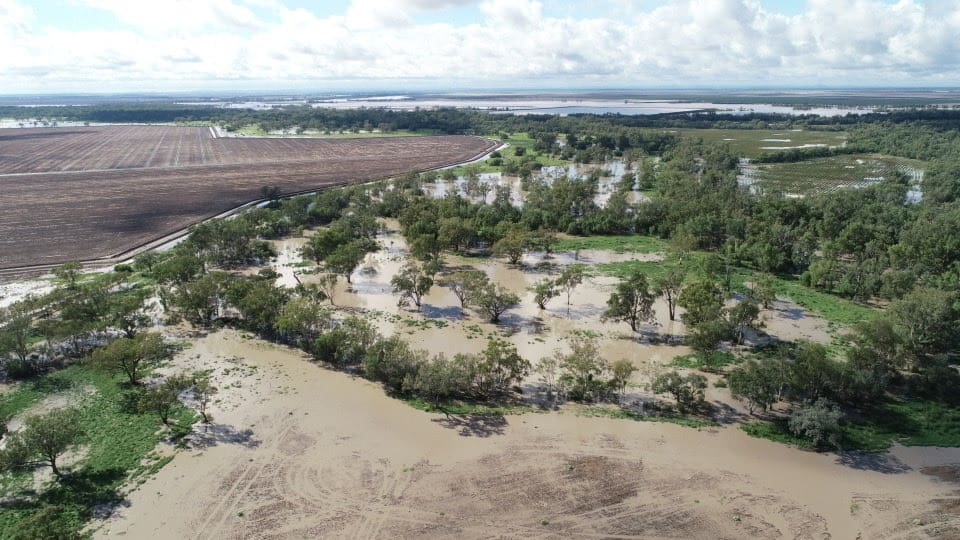
Paddocks in the Moree district are saturated after heavy rain and flooding from rivers and creeks. Photo: Tony Lockrey
WHEAT and barley prices across eastern Australia have fallen by up to $8 per tonne in the past week following rain which has assured a widespread and timely plant of winter crop in many parts of New South Wales and Queensland.
Rainfall in the week to 9am today has totalled 50-200 millimetres in many cropping regions, and is ideally timed with the wheat and barley planting windows now opening.
The rain has closed some roads including highways in parts of southern Queensland and northern and central NSW, including around Sydney, and also put a one-week stop to trains carrying grain to both export terminals in Newcastle.
While the Moree-Narrabri rail line remains closed due to flooding, other arteries are reopening as waters recede.
Traders say with some juggling of pick-up locations, domestic consumers are able to source sufficient grain for near-term needs.
| This week | Last week | Change | |
| Barley Downs Apr | $267 | $275 | Down |
| Barley Melbourne Apr | $250 | $255 | Down |
| Barley Melbourne Jan | $244 | $250 | Down |
| Sorghum Downs Apr-May | $305 | $303 | Up |
| Wheat Downs Apr | $295 | $303 | Down |
| Wheat Melbourne Apr | $295 | $300 | Down |
| Wheat Melbourne Jan | $295 | $300 | Down |
Table 1: Indicative prices in AUD per tonne.
Traders, growers selling
Market sources report traders as well as growers have been willing sellers ahead of and during the rain event of the past week.
“There’s a few trade longs starting to unwind now that we know we’re going to get a decent crop this year,” one trader said.
Feedlots on the Darling Downs are understood to have enough contracts in place to be able to draw grain from bulk handlers’ sites and on-farm storages with all-weather access, or in relatively dry spots.
“A lot of grain is stuck on the southern side of Moree waiting to get through with the highways closed, and logistics have been squeezed for the past few days.”
To catch up for a week of rain or flood-affected deliveries, many consumers are receiving grain over extended hours in coming days.
Agracom export manager Brett Donoghue said with rain improving the outlook for the NSW and Queensland winter crop, growers were now looking to sell grain left over from last harvest, and the market had reacted.
“It’s definitely softer across the board with the rain in Queensland and NSW,” Mr Donoghue said.
He said offshore demand was driving wheat prices, while in the northern market, domestic demand from feed millers was supporting barley values.
“Barley in the south is about $50/t under wheat; it’s more like $20/t in the north where the rations are heavy on barley.
“Growers have sold a fair percentage of their grain in the system — maybe 70-80 per cent — but there’s more grain on farm to come to market.
“There’s no point in storing grain and looking for more value; the market won’t pay you for anything it doesn’t need.”
Looming in the buyers’ mind is the upcoming Northern Hemisphere new-crop, and Mr Donoghue said the inverse expected in July-August of US$30-$40/t for wheat was driving today’s selling interest.
“If there are no problems with the Northern Hemisphere crop, the market is probably going to come under more pressure, and this week and last week we’ve seen a noticeable increase in grower selling.
“The reality is the back half of this year is an unknown, and at this stage it looks like values are going to be well below where they have been.”
Sorghum bucks trend
Sorghum crops in southern and central Queensland and northern NSW range from being harvested to barely in head based on the wide planting window which closed last month.
While later crops will benefit no end from the recent rain, others which were nearing harvest may suffer some downgrading.
“I wouldn’t want to be short Sorghum 1 for April delivery,” one trader said.
A considerable amount of sorghum has already been harvested, and is making its way to poultry feedmills and to export for China.
Drier in south
In Victoria, grower broker David Matthews said farmer-to-farmer sales in the south were taking place at around $225/t for barley, down around $5/t in the past fortnight.
Mr Matthews said prices from the latest Saudi barley tender indicated growers should be seeing stronger bids than they were from the market, and many were opting to sell current-crop pulses instead.
“They’re seeing strong prices for lentils, and for kabuli chickpeas too, so growers who want to get some sales on are going for those.”
Mr Matthews said many growers in the Wimmera had wheat and barley in warehousing and on farm to sell, and bids from up-country container packers were grabbing some interest.
While Victoria’s high country and dairy areas had some heavy rain in the past week, falls in the major cropping regions were mostly light, but up to 30-50mm in places.
Following soaking in late summer, Mr Matthews said most of the Wimmera was only a rain or two away from planting.
“There’s reasonable subsoil moisture, so everyone’s pretty comfortable with where we are.”
Grain Central: Get our free cropping news straight to your inbox – Click here

HAVE YOUR SAY